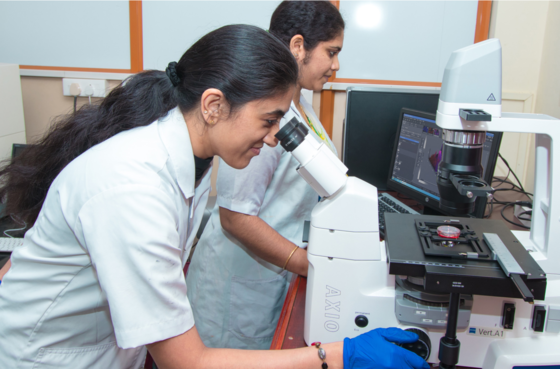Research at AIMS - Amrita Institute of Medical Sciences

Chancellor’s Message
“Knowledge is like a river. Its nature is to constantly flow. Wherever it can flow, it does so, nourishing culture. On the other hand, the same knowledge, if devoid of values, becomes a source of destruction for the world. When values and knowledge become one, there can be no more powerful instrument for the welfare of humankind. Today, physicists have even begun investigating the possibility that the essential substratum of the manifest universe and the individual are one and the same. We are standing on the threshold of a new era wherein material science and spirituality will move forward hand in hand.” - Mata Amritanandamayi Devi , Chancellor, Amrita Vishwa Vidyapeetham
Research
Researchers at AIMS have utilized Calcium Phosphate, a substance commonly found in bones, as a potent weapon that can seek and kill tumor cells. They demonstrated that iron-doped calcium phosphate nanoparticles 10 orders of magnitude smaller than a particle of dust, can be guided to the liver where tumour-afflicted tissues can be scarred using radio waves. This technique of using radiowaves to kill cancer cells is called Radiofrequency (RF) ablation. Scientists elsewhere have been developing it as a plausible treatment for cancers of other organs such as the lungs, liver, and esophagus. The current challenge with RF ablation is that because the thermal conductance of tissues is low, heat will not spread well enough throughout an area that is large enough to kill all the cancer cells in the target. Presently, it is useful when the cancer is restricted to an area of 3-5 cm.
The researchers are hoping they can evenly spread these nanoparticles through the cancer cells if they can be tagged with certain tumour- specific molecules which are able to bind to the malignant cells. “Most of the materials currently being explored as heat-generating materials for RF ablation, such as gold nanoparticles, carbon nanotubes or graphene, suffer from an inherent problem - they are non-biodegradable. Calcium phosphate, on the other hand, being part of bone mineral, is easily biodegradable”, said Dr. Manzoor.
Experimental Investigation on Preconditioned Rate Induced Tipping in a Thermoacoustic System
This area of research is about how a preconditioned rate induces tipping in a thermoacoustic system. Many systems found in nature are susceptible to tipping. This means they can shift from one stable dynamic state to another. The shift in dynamics can be unfavourable in systems found in varying fields ranging from ecology to finance. Hence, it is important to identify the factors that can lead to tipping in a physical system. Tipping can mainly be brought about by a change in a parameter or due to the influence of external fluctuations. Further, the rate at which a parameter is varied also determines the final state that the system attains. In this paper, it is shown that a preconditioned rate induced tipping exists in both experiments and in a theoretical model of a thermoacoustic system. A specific initial condition is provided (preconditioning) and a parameter is varied at a rate higher than a critical rate to observe tipping. It has been found that the critical rate is a function of the initial condition. This study is highly relevant because it shows that the parameters that dictate the asymptotic behaviour of many physical systems are temporally dynamic.
Cancer Cell Labeling by Detecting Mitochondrial Hydrogen Sulfide
The application of a chemodosimeter ‘turns on’ the fluorescent probe for detecting endogenous H2S formation in cancer cells. Mito-HS shows a bathochromic shift in UV-vis.-absorption spectrum from 355 nm to 395 nm in the presence of H2S. Furthermore, it showed ~ 43- flouorescence enhancement at λem 450 nm in the presence of H2S (200 μM). The cancer cell-specific fluorescence imaging reveals that Mito-HS has the ability to distinguish cancer cells from normal cells based on the level of endogenous H2S formation. In due course, Mito-HS would be a powerful cancer biomarker based on its ability to estimate endogenous H2S formation in living cells.
A Systems Model of Parkinson’s Disease Using Biochemical Systems Theory
This research connects experimental data related to dopaminergic cell death from several molecular levels to conditions attributed to Parkinson’s Disease using a mathematical method called Biochemical Systems Theory. Parkinson’s Disease is a neurodegenerative disease or a disease of the central nervous system that primarily affects motor nerves. Its symptoms include rigidity, shaking and a general slowing of movement. Various individual observations usually lead to hypotheses used for diagnosis and therapy in biomedical and clinical research such as in the case of Parkinson’s Disease (or PD). Parkinson’s Disease is related to the slow death of dopamine-producing neurons (brain cells). For brain diseases, connecting molecular levels to brain functions is a complex endeavour that involves different types of experimentation at various levels. Therefore, it is important that hospital clinicians are able to connect various laboratory experimental findings in order to accurately study the onset and progression of brain disease.
